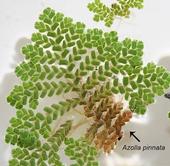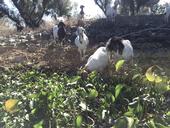- Author: John A Roncoroni
- Posted by: Gale Perez

There have been several recent questions about dealing with a plant floating in reservoirs. Here's Weed Scientist Emeritus John Roncoroni's response to them.
* * * * * *
Pacific Mosquitofern, (Azolla filiculoides) often referred to as Azolla, is native to California. It is considered a desirable component of natural habitats and an important food source for waterfowl. Azolla is a floating aquatic fern that spreads by stem fragments and spores. Azolla as being up to 5 cm (2 inches) long, but can be as small as ¼ to ½ inches.
Azolla is often misidentified as duckweed (Lemna spp), another common small floating aquatic plant. Azolla is initially green, like duckweed, but...
- Posted by: Gale Perez
POSITION: Plant Ecologist / Plant Physiologist / Agronomist
LOCATION: Davis, CA
ANNOUNCEMENT #: ARS-D23PWA-12001468-mds
CLOSING DATE: July 12, 2023
LINK TO JOB DESCRIPTION: https://www.usajobs.gov/job/731291100
* * * * * *
The United States Department of Agriculture (USDA), Agricultural Research Service (ARS), Invasive Species and Pollinator Health Research Unit is seeking a full time Plant Ecologist or Plant Physiologist or...
- Posted by: Gale Perez

| Working title: | Senior Environmental Scientist (Specialist) -- Boating & Waterways Division / Aquatic Invasive Species Branch / Floating Aquatic Vegetation Program |
| Job code #: | JC-214183 |
| Position #: | 549-708-0765-002 |
| Location: | Sacramento County, California |
| Apply by: | Sept. 10, 2020 |
| More information: | Click HERE |
Job...
- Posted by: Guy B Kyser

Dr. John Madsen (USDA-ARS Invasive Species and Pollinator Health, Davis, CA) just received the 2020 Outstanding Scientist Award from the Northeast Aquatic Plant Management Society. The letter of recognition says, among other things, "The Society recognizes you for your ongoing support of students, and your commitment, contributions and dedication to the field of aquatic plant management."
Dr. Madsen has participated in Weed RIC since 2014. He has developed a program studying phenology and management of waterhyacinth, Brazilian egeria, curlyleaf pondweed, and other species, concentrating mostly on the Sacramento-San Joaquin Delta.
- Author: John Miskella
- Author: Guy B Kyser

In late October we made our monthly trip to sample curlyleaf pondweed in the Sacramento-San Joaquin Delta. On an island in the lower San Joaquin river, we spotted goats eating waterhyacinth (Eichhornia crassipes) and waterprimrose (Ludwigia sp.) along the shoreline.
The goats were accompanied by a benevolent and protective llama, who showed no interest in the weeds.


